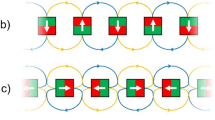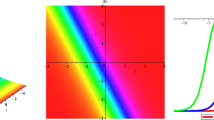Abstract
A novel axially modulated, annular electron beam cusp-injected, slowly varied section opened cavity, hybrid-magnicon amplifier had been proposed I once. The hybrid-magnicon has wavelength up to millimeter wave bend. The while its non-self-consistent non-space-charge nonlinear numerical calculation method was discussed. But due to bunch effect is changing uniform distribution state of the annular electron beam in the driver cavity, and then dynamic force balances of the beam is changing. Therefore, besides the interaction force between electron beam and the rotating TMn10 mode electromagnetic field also must consider the electromagnetic force of current density and the action force between the space-charges and the action force of the charge density grade, et al. effect. For some problems of theory, this report try discuss from Maxwell Equations.
Similar content being viewed by others

References
O. A. Nezhecenko, Gyrocons and Magnicons: Microwave Generators with Circular Deflection of the Electron Beam, IEEE Trans. Plasma sce. Vol. 22,No. 5, pp. 756–772, 1994.
B. Hafizi, et al., Analysis of the Deflection System for a Magnetic-Field-Immerset Magnicon Amplifier, IEEE Trans. Sci. Vol. 20, pp. 232–239, 1992.
B. Hafizi, et al, Nonlinear analysis of a magnicon output cavity, Phys. Fluids B, Vol. 5,No. 8, p. 3045, August 1983.
Zhang Hebi, New type microwave tube—magnicon, External science technology reference, (the Chinese language), 1994, No. 2–3, p.64.
Zhang Hebi, Research for a new type leng pulsed & high efficient microwave amplifier magnicon, Vacuum electronics, (the Chinese language), No. 5, 1997. (Series No.210), pp.6–11.
Zhang Hebi, The cold quality factor of magnicon on resonator in the rotating TMn10 mode, High power laser & particle beams, Vol.9,No.3, pp336–340, 1997.
Zhang Hebi, Analysis for the new type long-pulsed and high efficient magnicon, Inter. J. Infrared & Millimeter Waves, V.18,No. 6, pp. 1381–1391, 1997. 6.
Zhang Hebi, The cold quality factor of magnicon on resonator in the rotating TMn10 mode and compared with its equivalent for the static mode, Inter. Confer. of Microwave & Millimeter Wave Technology, August 1998., in Beijing China, pp. 528–530.
Zhang Hebi, The axial modulated cusp-injected slowly varied section opened cavity magnicon amplifier, Inter. J. Infrared & Millimeter Waves, Vol.21,No. 1, January 2000.
Liu Shenggang, Relativity electronics, (the Chinese language), Science publishing house, Beijing, April 1987.
Yan Yang, Azimuthal angle direction many conductor high order harmonic gyrotron study, Doctor treatise, Electron Science & Technology University, 1994.
Cao Changqi, Electrodynamics, (the Chinese language), People's educate publishing house, Beijing, China, July 1962.
Simon Ramo and John R. Whinnery write, Fields and Waves in Modern Radio, (the Chinese language), People post telecommunication publishing house, Beijing, China, May 1963.
Author information
Authors and Affiliations
Rights and permissions
About this article
Cite this article
Zhang, H. A Theory of the Self-Consistent and Space-Charge Effect in Hybrid-Magnicon Amplifier. International Journal of Infrared and Millimeter Waves 21, 201–207 (2000). https://doi.org/10.1023/A:1006644616211
Issue Date:
DOI: https://doi.org/10.1023/A:1006644616211



